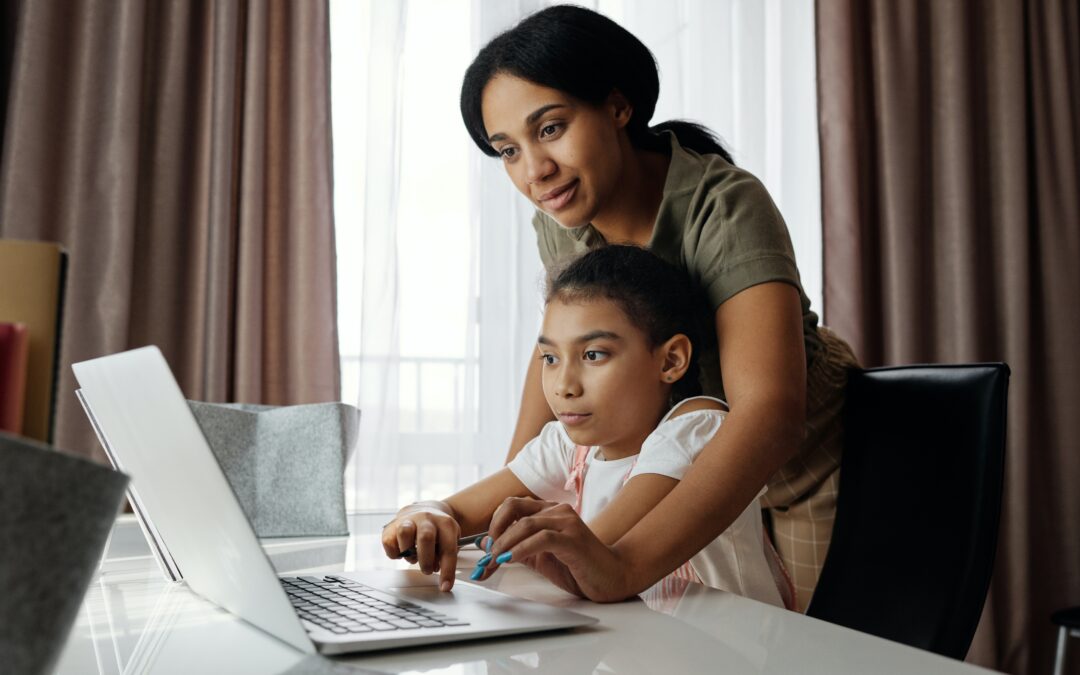It’s been over a year since we’ve been at home. And for some of us, that means we’ve embarked on an adventure we didn’t sign up for: at home e-learning. Whether you’re a parent, teacher or a supportive friend and auntie, you’ve encountered some of the hurdles of educating in a pandemic. And while some of us may have initially relished the idea of extra family time, many of us have run out of steam. We asked two of our alumnae to provide their expert advice on how to help students excel and keep parents sane.
Lisa Kahnert (class of 1982) is an Education Consultant / Tutor who specializes in S.S.A.T. preparation. She enjoyed many years of in-class teaching before moving into a focused tutoring roll. Sara Pedrosa (class of 2003) is a high school teacher who has taught in class, online and asynchronously throughout the pandemic.
Kids Love Structure
They both stressed the importance of structure. We all need boundaries to hold ourselves in. Kids are no different. Lisa recommends (setting things up) developing a plan with your child, the night before, to be mentally prepared for the day ahead. This could mean discussing what the schedule will look like, which outfit we’re going to wear or which activity we’re going to do.
In discussing the importance of structure she recounted the story of one of her students who was having a rough day. When she asked him what was troubling him, he replied by saying, “My parents don’t love me.” When she asked him “What makes you say that?,” (to explain why he felt that way) he said it was because, “they let me do whatever I want”.
She also suggests using a timed approach during the day. If you can get through so many minutes of performing a task, then you get a reward, which could be a snack, activity time or anything else that serves as positive reinforcement.
With our more independent high school students, we’re seeing a disruption in their schedules. Without the need to get dressed and go to class, the idea of a “school night” has become blurred with weekend evenings. Sara encourages the idea of sticking to a bed time and bed time routine and to avoid electronics at least an hour before settling in for sleep.
Positive Reinforcement, Reinforces Positively

Solution Focused Brief Therapy is one of the tactics Lisa uses to keep her students engaged and focused. You can read more about this approach here. Lisa works on the premise that we all know what works for us, so she often asks her students to think of a time they were successful and uses that to build behaviours that will allow for continued success.
We can also consider this when it comes to thinking about the pandemic overall. Instead of focusing on the things they’ve lost during the pandemic such as learning gaps or time with their friends, Sara recommends an asset-based approach that focuses on what they’ve gained. So maybe we missed out on a math class, but we got to experiment with baking which involves math skills such as fractions.
Conversation Is Empowering
Asking questions and engaging the students is a great way to warm them up, but also a way to encourage self-discovery and growth. Lisa often asks students to rate things on a scale from 1 -10. They could rate their performance on an assignment as a 7, for example. Then Lisa encourages them to think about the positive aspects of that number and feel good that it is not lower. On the flip side, by getting them to remember what has worked for them in the past, they are then asked to share 1 thing they could do differently that would raise the number, even a little. This conversation builds the student’s confidence, that they actually do know what to do. It takes the perceived “adult lecture” out of the conversation and puts them in the driver’s seat, no matter how old or young they are.
This will lead them to think about the cause and effect of their choices and hopefully motivate them to make better choices going forward.
Here are a few of the things our experts think are worth giving a try:
For the Little Ones:
Workbooks
Memory Games
Solution-Focused Conversations
For Your Teens:
Task lists
Setting time limits
Setting overall holistic goals with academia only playing a part in those
In writing this article with the goal of improving the learning experience for the kids, we’ve come to realize that many of these tactics can also be used in our adult lives. Let us know what you think or if you have any tricks that have worked for you.

